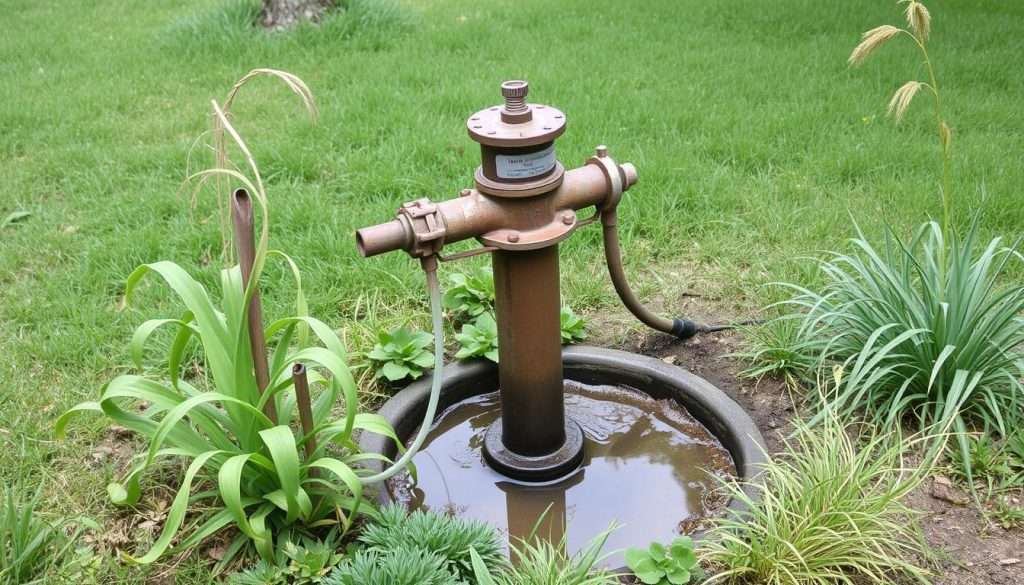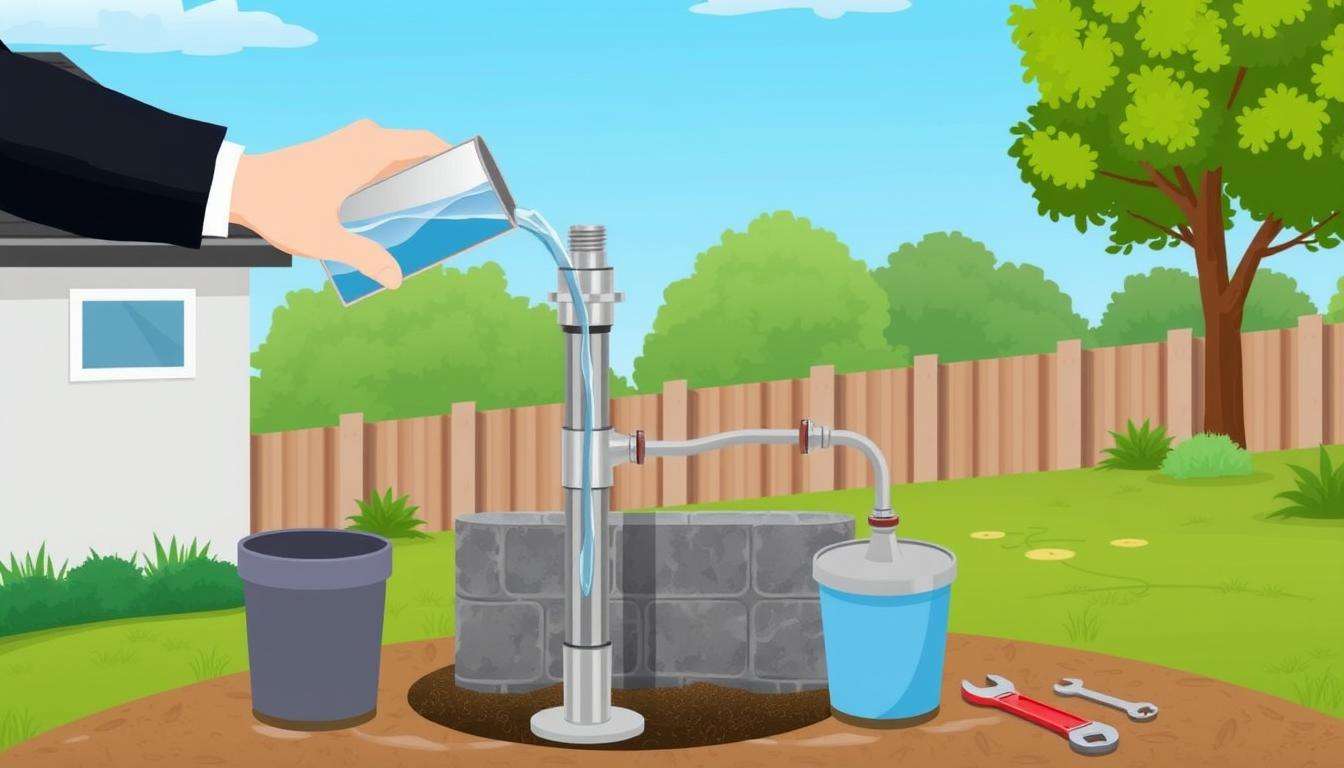Welcome to our guide on how to prime a well pump. We make it easy with simple steps. Keeping your well pump working well is key for good water at home. Learning to prime your pump yourself can save you money and stress.
Proper priming makes your pump work better and last longer. We’ll cover the basics of well pumps and when you might need to prime it. You’ll get a clear guide to make priming easy and effective.
Key Takeaways
- Priming a well pump is vital for efficient operation and water delivery.
- Understanding different types of well pumps can help identify the right priming method.
- Signs of needing to prime include low water pressure and continuously running pumps.
- Follow a clear step-by-step guide for successful priming.
- Regular maintenance contributes to longer pump lifespan and optimal performance.
- Seek professional help for complex issues or persistent problems during priming.
Understanding Well Pumps and Their Function
Well pumps are key for getting water from underground. They pull water from wells and cisterns. This gives homeowners a steady water supply. Knowing about well pumps helps you keep your system working well.
What Is a Well Pump?
A well pump lifts water from underground to the surface. It’s used in homes and businesses. Without knowing how well pumps work, you might face water problems. There are many types of well pumps for different needs and well depths.
Types of Well Pumps
- Shallow Well Jet Pumps: Great for wells under 25 feet, these pumps work well for shallow water.
- Convertible Jet Pumps: These pumps are good for wells up to 90+ feet. They meet many household needs.
- Deep Well Submersible Pumps: For deeper wells, these pumps are submerged. They can pull water from up to 400 feet deep.
How Well Pumps Work
It’s important to know how do well pumps work for good maintenance. Well pumps use pressure to push water through pipes. They work in different ways, depending on the type.
| Type of Pump | Depth Capability | Functionality |
|---|---|---|
| Shallow Well Jet Pump | Up to 25 feet | Uses suction to draw water. |
| Convertible Jet Pump | Up to 90+ feet | Versatile; can operate as a shallow or deep pump. |
| Deep Well Submersible Pump | Up to 400 feet | Submersible operation provides efficient water delivery. |
Knowing about the different types of well pumps helps you keep your water supply steady. This is important for your home.
Signs Your Well Pump Needs Priming
Knowing when your well pump needs priming is key. Ignoring signs can cause big problems. Here are signs your pump might need help.
Low Water Pressure
Low water pressure is a big sign. If your water flow drops, it’s a problem. This can happen for many reasons, like blockages or leaks.
Checking your water pressure often helps catch problems early.
Pump Running Constantly
A pump that never stops is a bad sign. It means the pump is working too hard. This can wear it down and cost more to run.
Look for leaks or other issues that make the pump work too much.
Dry Pipes or No Water Flow
Having no water is a serious sign. It means the pump has lost its prime. This can happen for many reasons, like a dry well or damaged parts.

| Signs | Causes | Actions |
|---|---|---|
| Low Water Pressure | Leakage, blockages, malfunctioning parts | Inspect system, check pressure tank |
| Pump Running Constantly | Loss of prime, leaks, blockages | Verify connections, re-prime if necessary |
| Dry Pipes or No Water Flow | Dry well, damaged pump, blockages | Check water levels, assess pump integrity |
Tools and Materials Needed for Priming a Well Pump
Knowing what tools and materials you need to prime a well pump is key. The right tools make the job easier and keep the pump safe. Having the right stuff helps you do the job well.
Essential Tools
First, you’ll need these necessary priming tools:
- Garden hose or washing machine hose
- Lead-free bucket
- Prime plug wrench
- Seals and connectors in good condition
Before you start, check the pipes and fittings for damage. Look at the safety guards, belts, and pulleys too. Make sure they’re all in place. Open any relief valves to help the pump work better.
Recommended Safety Gear
Wearing the right safety gear is important:
- Work gloves to protect your hands
- Safety goggles to keep your eyes safe from debris
- Protective clothing that can handle rough conditions
Having these things ready makes the job go smoothly. It also helps keep the pump safe.
| Tool/Material | Purpose |
|---|---|
| Garden Hose | Connects to an independent water source for priming |
| Lead-Free Bucket | Holds water for priming the pump |
| Prime Plug Wrench | Used to open and close the priming port |
| Safety Gear | Protects against injuries while working |
Step-by-Step Guide on How to Prime a Well Pump
Ready to learn how to prime a well pump? Follow our easy guide. We’ll show you each step to prime your pump right.
Step 1: Turn Off the Power
Your safety is first! Always turn off the pump’s power. This prevents electrical accidents during priming.
Step 2: Check the Water Level
Next, check your well’s water level. A low level can make priming harder. Some pumps need a certain water amount to work well.
Step 3: Locate the Priming Port
Finding the priming port is key. Most pumps have a special port for this. Make sure you know where it is in your pump.
Step 4: Add Water to the Pump
Now, fill the pump with water. Use a hose or bucket until it’s full. Follow the steps carefully to avoid problems. Check for leaks after adding water, as high pressure can damage fittings or valves.

Troubleshooting Common Issues During Priming
When you have trouble priming your well pump, knowing the problems is key. Finding and fixing these issues can stop future problems. This way, your system works well.
Air Leaks and Cavitation
Air leaks happen on the suction side of well pumps. They cause the pump to lose prime. This can make the pump less efficient and reduce water flow.
Look for leaks in:
- Improperly installed check valves
- Worn mechanical seals
- Loose fittings and connections
To find air leaks, watch the pressure gauges after priming. If the pressure drops, look for air.
Blockages and Obstructions
Blockages in the pump system can stop water flow. This makes priming hard. Check:
- Suction pipes
- Filters
- Pump housing
The dry prime test can find blockages. A vacuum of negative 22 inches of mercury shows leaks. If you don’t clear blockages, you’ll need to prime often.
When to Call a Professional
Some problems need a pro. Call for help if:
- You keep having the same problem
- Your pump needs to be primed a lot, meaning seal issues
- Blockages keep coming back and affect how well it works
| Issue | Symptoms | Solutions |
|---|---|---|
| Air Leaks | Loss of prime, fluctuating pressure | Inspect seals, check valve positions, replace damaged components |
| Blockages | No water flow, low pressure | Clear suction pipes, replace filters, ensure proper assembly |
| Cavitation | Unusual noise, reduced efficiency | Check water source, inspect for air entrainment, adjust pump speed |
Maintenance Tips for Your Well Pump
It’s important to keep your well pump working well. This ensures you always have water. By following some tips, your pump will last longer and work better. Regular checks, cleaning, and seasonal care are key. Here are some important maintenance tips.
Regular Inspections
Regular checks help find problems early. This way, you can fix them before they get worse. Look out for:
- Signs of wear and tear on the pipes
- Visible leaks around the pump area
- Changes in water pressure
- Unusual noises coming from the pump
Cleaning and Debris Removal
Cleaning your well pump removes blockages. This keeps water flowing well. Make sure to:
- Clear debris from around the pump and well head.
- Deal with mineral buildup, like iron or calcium.
- Check for pests, like wasps or termites.
Seasonal Maintenance Checklist
A good seasonal checklist keeps your pump in top shape. Here’s what to include:
- Inspect and clean the pump and well surroundings.
- Test water quality, focusing on hardness and contaminants.
- Check electrical connections and circuit breakers.
- See if you need to add salt crystals to the brine tank.
Conclusion and Final Thoughts on Well Pump Care
It’s very important to take care of your well pump. This care helps it work well now and for a long time. Making sure it’s primed right is key. It keeps your water flowing well and saves you money on repairs.
Importance of Proper Priming
If your pump loses its prime, it might not work right. This can make your water levels low and put extra stress on your system. Knowing how to prime your pump and checking parts like the foot valve helps a lot.
Long-Term Benefits of Regular Maintenance
Regular checks on your well pump keep it running smoothly. This also makes your water better. By following these steps, your well system will stay healthy for a long time. This gives you peace of mind, knowing your water is safe.
